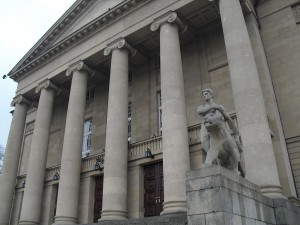Perfectly Polish Poznań, Sans Sleep
“But even George Bush is very popular among Polish people.”
It’s true. When George W. Bush visited Poland in 2001, 2003 and 2007, he was treated like a rock star — as was Mitt Romney on his European tour as part of his failed 2012 presidential bid.
Conservatism runs in Poland’s blood. The late Pope John Paul II was the first Polish pope, inspiring millions to practice their faith more openly and others to become among the most devout members of the Roman Catholic Church. Middle-of-the-road political parties have held power since 1995. Contemporarily, the level of acceptance both legally and informally of LGBTQIA (lesbian, gay, bisexual, transgender, queer, intersex and asexual) individuals is seen as lagging behind that of Western Europe.
“So what are you doing in Poznań?” the barista asked.
“Funny story,” I began. I relayed the tale of my 600-kilometer ride in a van full of catty, man-eating fashionistas, my night surrounded by real-life vampires, and the four-hour bus trip immediately after, which if it were still the Cold War would be called “The Arduous Ride.”
“Sounds odd,” she said.
I laughed. “You have no idea.”
A pause, “How long are you here for?” she inquired. It was a good thing there wasn’t anyone else in line waiting for their morning caffeine fix.
“Well,” I started, “that’s the sad part. I fly back tonight.”
“That’s not very long.”
“No, it’s not.” I paused. “So, I really don’t know anything about Poznań. Anything you’d recommend I see while I’m here?” Best way to know what to do in a new place: ask a local.
“There’s not much,” she said.
“C’mon, don’t sell yourself short!” I teased. “So far I really like it here. Maybe there are some historic things or a place everyone knows?”
She stared off for a moment. I could tell she was thinking about something.
“You should see the castle,” she said, brown eyes boring straight into mine.
Castle? I did have a soft spot for those hulking hallmarks of medieval architecture.
So began a tour guide-esque briefing on the Imperial Castle (Polish: Zamek Cesarski w Poznaniu). The imposing structure, built in 1910 for the German Kaiser and later serving — rather unfortunately — as an official residence of Adolf Hitler (complete with a study made to look exactly like the one in the Reich Chancellery, still intact despite the extensive damage the castle sustained) is an arts, history and culture mecca, she told me. And to boot, it was only a few blocks away.
I booked it over there with the speed of Lindsay Lohan on her way to the nearest drinking establishment.
Poznań is a city of hidden architectural treasures, and sure enough, the castle did not disappoint — despite the constant stream of traffic circling it like ants around an anthill.
At once imposing, it strangely didn’t seem too out of place. That was probably, I decided, because all four sides of the box-like behemoth were draped with some manner of an advertisement or another — be it for upcoming exhibitions at the museum inside, local restaurants or — strangely enough — a hair salon of some type or other; either that place had the largest advertising budget in the history of hair salons, or it was unquestionably the best place in the world to get one’s hair trimmed.
I ventured across the four-lane road, traffic bumper-to-bumper in what must have been the Eastern Bloc version of Midtown Manhattan. Several honking horns, incomprehensible swear words and friendly gestures from motorists later, my heart finally began beating again as I stared at the smooth stone walls that made up the exterior.
The Imperial Castle also hosts numerous private events, and today, it was closed. Oh, well. I snapped a few pictures of what I could, marveling at the similarity between the main turret and that of another ornate building I’d seen previously: the Cathedral of Saint Peter in Trier, Germany. The similarities, from the overall layout to the positioning of the turrets in relation to other buildings in the nearby area, were startling.
But my wanderings were working up an appetite — that and the steady rain was making me miserable. My jacket was going to turn to mildew if I didn’t dry off at least for a bit.
What was I to eat? I was in Poland, so why not Polish food? But, what was Polish food? Polish dogs? Was that even Polish? That was very doubtful.
Grappling with indecision, I passed a bright red sign with a panda on it. I didn’t understand the Polish writing, but the pictures of steaming bowls of noodles, vegetables and meat with chopsticks told me one thing: Chinese food. As if on cue, my mouth began salivating.
The place was Wook, a chain of midrange Chinese restaurants found in several Polish cities. Chinese? In Poland? I had to try it.
Stepping out of the rain, the first thing that greeted me was a P.F. Chang’s-like infusion of polished wood, stone, and overly large red vases. Fake bamboo was placed haphazardly throughout in some feng shui arrangement meant to create harmony, though to me it screamed controlled chaos. The grill was deliberately placed in plain sight of the dining area, where a row of white-clad chefs in overly large hats flipped various meats and vegetables as flames exploded below. Was this how restaurants were in China? That was doubtful. But it did seem just like any U.S. establishment specializing in higher-end Asian cuisine.
My waiter — who spoke excellent English — directed me to a window seat booth. It felt odd having so much table space occupied by just a single person, but then again every table was made for at least four; apparently this place was a hit with families.
(Article continued on next page)

